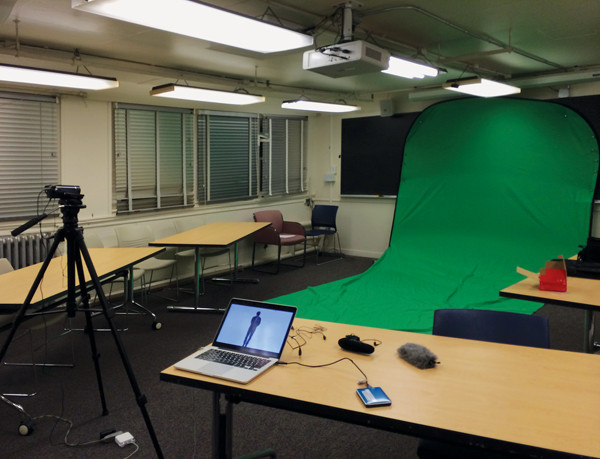
by Allison Mills Tuesday, November 4, 2014

MIT students in the Experimental Study Group learn to shoot short educational videos, even using a green screen to include special effects. Credit: Christian Cardozo.
Across the Internet, science shows abound, such as “Crash Course,” “The Brain Scoop” and “Vsauce.” A good educational video is like watching a professional ballerina — if the dance is done well, it looks effortless. Of course, neither ballet nor film is actually easy, especially when the medium is meant to carry a message. A new class at MIT is helping students break down the steps and twirls of video and having them choreograph their own short educational films — with the goal of teaching them to better communicate, and deepen their own sense of the science, by explaining complex ideas like the Big Bang, the architecture of the Wheatstone Bridge or the chemistry of bread.
First run last spring, the inaugural class is part of the Experimental Study Group program (ESG), which operates on the idea that innovation stems from creativity, and is a new way MIT is getting their students to think outside the box when it comes to communicating their science. While ESG is a learning track and offers fundamental science courses in small, discussion-based classes, it is also a community. Currently totaling 55 freshmen, 40 upper-class students and nine faculty members, the program is designed to engage students with their studies, each other and big ideas.
The format of the video course is very different compared to what science students are typically exposed to in science class. “We never just read books or sat in lectures,” says Christian Cardozo, an electrical engineering and computer science major at MIT who took the course. “The class was action-driven.” And although the content “was science-driven,” he says, “the production was artistic.”
Students had cameras in hand on the first day; by the end, each had produced a super short video. To guest instructor John Copeland, who helped produce the American Geosciences Institute’s “Faces of Earth” and the Discovery Channel’s “Dinosaur Planet,” the process is about learning to engage. “There’s a reason the stories on NPR stick with you long after the hourly news updates,” he says. “They engage us on a level that tweaks our brain.” Basic storytelling, Copeland says, is vital to our species and how we process information. Throughout the class, he tries to get his students to think about abstract information in a narrative.
Teaching science effectively and moving away from the “cookbook approach” helps students engage, says David McConnell, a geologist at North Carolina State University who researches geoscience education and is working with other researchers to incorporate and examine videos in geology classrooms. He says that regardless of whether the learning is through in-class exercises, film or term papers, “it’s not about repeating what we already know, it’s about trying to stretch to the edge of our well of knowledge.”
For Cardozo, who made a 10-minute video about cosmology, the multimedia work pushed him to a deeper understanding of the science. “You can know tons about physics, but you have to express it in a deliberate manner,” he says. That’s especially important for presenting at conferences, defending research and teaching, he adds.
Even if some geologists joke that they like rocks more than people, communication skills are invaluable, Copeland says. Building a marketable toolbox is not the only benefit of scientists learning film. “Bill Nye was really popular with kids because he would do these things that would startle you and make you go, ‘Whoa! Hey, that’s cool,’” Copeland says. Piquing a viewer’s curiosity is key: “You want to engage the audience like this so that they’re going to take away something after the screen goes dark.”
Copeland says this is an easy sell for geology because “it’s about our home.” Geologic concepts are sometimes complex and abstract but “we need to be able to live here,” he says. “We need to understand how our home works, what it has been through Deep Time in order to anticipate where our future may be going.” Relaying that on a screen is possible since “geoscience is something you can touch, you can see, you can breathe, you can hear.”
Copeland says he hopes to run the class through ESG as a workshop and will work with students this fall to produce a short film for the program, giving them another chance to re-envision their science studies through video.
© 2008-2021. All rights reserved. Any copying, redistribution or retransmission of any of the contents of this service without the expressed written permission of the American Geosciences Institute is expressly prohibited. Click here for all copyright requests.